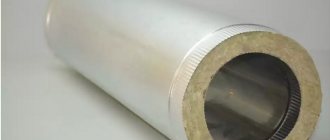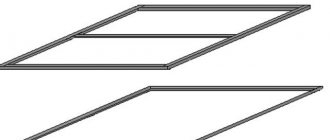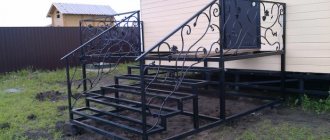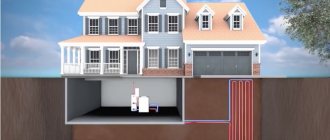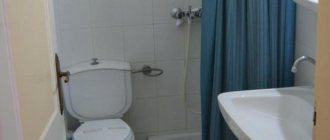A heated towel rail in the bathroom is necessary. It maintains a pleasant microclimate in the room, dries not only towels, but also the air, and prevents the appearance of mold and mildew. But a reliable design made of stainless pipes, even the simplest one, will require certain costs. For those who have experience in plumbing work, it is easy to make and install a propylene heated towel rail with your own hands. A homemade dryer will cost less, its shape and size can be adjusted to the location, and it will work no worse than a finished product. However, there is a danger of incorrect connection and unreliable connection. In the event of an accident, the bathroom will not be filled with cold water, but with boiling water. Beginning home craftsmen without experience working with polypropylene pipes should not take risks.
Types of heated towel rails based on operating principle
There are three types of dryers installed in the bathroom:
- water device;
- powered by electricity;
- combined model.
To choose which heated towel rail to use in the bathroom, you need to study the operating principle of each type.
Water type device
To make a water heated towel rail, copper, chrome-plated brass, stainless steel, black steel, and nickel-plated are used.
The priority is to use stainless steel. This is explained by the fact that this material can withstand increased surges in water pressure.
The description of the operating principle of the water model resembles the operation of a heating battery: hot water is supplied from the main line to the radiator. Then it moves through the pipes of the drying structure. At this moment, heat is released into the room. The liquid enters the water supply or heating system through the return pipe.
The advantages of the water model only confirm the correctness of its choice:
- after installation, electricity bills will not increase, since the dryer is not connected to the electrical network;
- The installation itself is simple and does not require additional measures (grounding, special moisture-resistant sockets);
The biggest problem faced by owners of a water structure powered by a heating network is the suspension of its use during the non-heating season.
Electric model
The heating element is a cable or heating element, which are located inside the radiator. The coolant is water or antifreeze if a heating element is installed inside. When there is a cable in the pipes, the radiator is without liquid. Electric heated towel rails in the bathroom are equipped with a thermostat and rheostat. These devices are used to regulate the temperature inside the structure.
Such models are either mounted on the wall or installed on the floor using legs. Different materials are used for manufacturing, but stainless steel coated with chrome is recognized as the best.
The dryer runs on electricity supplied to the heating element. The coolant is the liquid inside the pipes. It is heated by heating elements to 60 oC, 70 oC. The heating level is maintained with the help of heating elements, or with the help of additional devices mentioned above.
Installation and installation of a new towel dryer
Independent consists of the following actions:
- Selection of installation type - water, electric or combined.
- Select the connection method - to hot water or a heating riser.
- Fixing a pre-assembled structure (coil-towel rail), purchased at a hardware store, onto brackets and connecting the ends of the installation to a hot water or heating riser.
- Calculation of the distance from the wall to the axis of the aluminum coil pipe, which depends on the diameter of the pipe itself. For example, if the diameter of the coil pipe is less than 23 mm, then it is recommended to take the standard distance to the wall at least 35 mm, with a larger pipe diameter - more than 50 mm.
- Checking the tightness of the coil mounted on the brackets.
- When installing the coil, observe a special slope (about 5-10 mm) so that the water coming from the heating riser or hot water pipe moves according to the pattern from top to bottom.
This event is quite complex and responsible, so if you are unsure of your capabilities, it is best to entrust the change of the coil in the bathroom to professional plumbers. They will perform the installation efficiently, with a guarantee, much faster than you and for an affordable price.
Metal pipes for the manufacture of a water device
Calculations of the power of the device are made based on the area of the room where the DIY heated towel rail will be installed, air humidity, and the presence of ventilation. The recommended thermal energy level is 150 watts per 1 m2 of room.
The ability of the device to heat the required area of the room depends on the height and width of the device being manufactured. This dependence is reflected in the table.
| Device dimensions: height/width, m | Room in m2 |
| 0,5/0,4; 0,5/0,5; 0,5/0,6 | From 4.5 to 6.0 |
| 0,6/0,4; 0,6/0,5; 0,6/0,6 | From 6.0 to 8.0 |
| 0,8/0,4; 0,8/0,5; 0,8/0,6 | From 7.5 to 11.0 |
| 1,0/0,4; 1,0/0,5; 1,0/0,6 | From 9.5 to 14.0 |
| 1,2/0,4; 1,2/0,5; 1,2/0,6 | From 11.0 to 17.0 |
For example, for rooms with the most common area of 4.5-6.0 m2, a model with dimensions of 0.53/0.5 meters indicated in the preliminary drawing is mounted.
To install a heated towel rail, the following materials are purchased:
- metal pipe with a cross section of 3.2/0.2 cm, length 300 cm;
- pipe outlet at an angle with a cross section of 3.2/0.2 cm - the quantity is individual for each snake design;
- “American” and bushings for it - 4 pieces each (depending on the model);
- fastening elements – 4 pcs. (depending on the model);
- number of decorative washers for fastening – 4 pcs.;
- M8 pin;
- M8 nut for the stud.
Without the selection of tools, installation will be difficult:
- welding tool;
- set of electrodes;
- argon;
- Bulgarian;
- metal discs;
- felt and grinding wheels;
- felt-tip pen, tape measure.
Stages of manufacturing a heated towel rail from metal pipes
The algorithm for performing work on the manufacture of a dryer from metal pipes is described as an example on the model from the drawing:
- Pipes of the required length are measured.
- The required pieces are cut with a grinder.
- Pipe sections are ground and polished using circles.
- Pieces of pipes with corner bends are connected into a single structure.
- The structure blank is connected to the bends.
- Welding seams are ground until the surface of the structure is smooth.
- Fastening elements are installed.
- The free ends are connected to the riser branches using “American” connectors.
- Checking all connections and final sanding of the entire surface.
Connecting a water heated towel rail to hot water supply or central heating
Heated towel rails can be connected to a hot water supply (DHW) or heating system. The first option allows you to dry bath accessories throughout the year, because... hot water is not turned off during the warm season. The dryer pipes heat up only when the coolant is consumed, so the device cools down completely overnight.
When connected to the heating network, you can use the heated towel rail only in the cold season. However, due to the forced circulation of hot water, it will remain warm around the clock.
Copper and brass heaters must be marked as galvanized and suitable for water supply risers.
Installation in a riser
The dryer is inserted in the following sequence:
- Preparation of materials and tools. To install a water heater you will need an adjustable wrench, a grinder, dies for threading, a low-speed drill, telescopic brackets, dowels and screws, American type taps, a Mayevsky tap (for air release), straight and corner fittings (depending on the type connections), sealant and sealant for joints. The system itself is assembled from a heated towel rail, a bypass jumper and several pipes, the length of which is selected depending on the layout and location of the device.
- Dismantling of old equipment. Work to remove the old device and/or install a new one will require permission from the management company (MC). Its employee closes the common hot water or heating riser for a regulated time. If there is an old dryer, it is removed from the threaded connections or cut off, and then removed from the mounts (brackets). If you are just planning to install the device, then a gap is cut out in the riser, which is slightly larger than the width of the heater.
- Preparation of bends and lintels, laying tiles. Ball valves are installed on the branches after the bypass. You can fix the system before finishing the room, but in this case the thickness of the glue and tiles is added to the distance to the wall.
- Marking for fastenings. It is carried out taking into account the slope of the branches, the horizontal position of the heater and the distance between its parts. After checking the markings, you can drill holes, screw in dowels and install brackets.
It is recommended to install a towel dryer during a major renovation of an apartment or when replacing a water riser. This will allow you to choose more reliable material options and a convenient connection diagram.
Self-installation of a simple configuration
Installation of the coil is carried out after completion of the preparatory work. Branch pipes, angles and fittings are connected to the finished bends. Each connection is sealed with fum tape or silicone gasket.
Installation of the heated towel rail is carried out simultaneously on the bends and installed brackets. The device is secured with screws.
Upon completion of work, the system is tested for functionality and tightness. The DHW or heating riser is temporarily opened, filling the heater with water. If the connection is made correctly, it circulates freely in the system, the joints do not get wet, and the metal surface remains hot.
Before installing the system yourself, you should watch training videos with instructions for installing the dryer (step by step and with all fittings).
Technology for working with the “Ladder” model
For heated towel rails of the “ladder” type, predominantly lateral and diagonal installation schemes are used. For bottom connections, you can install rotating angles and additional pipes on the bends, which will allow pipes to be brought in from the side.
Algorithm for creating an electrical model
The creation of a model powered by electricity is based on the design of a water device. Therefore, the work begins with its acquisition. In addition you will need:
- electric heating element for the device (power not less than 110 W), with an external threaded connection of ½ inch, with a temperature controller;
- plugs (external thread ½ inch) – 2 pieces;
- Mayevsky tap (external thread ½ inch) – 1 piece;
- for sealing tow joints.
Electric heated towel rails are most often found in the form of a “ladder” model.
- More often, the left rack is chosen, with plugs screwed in at the top and bottom;
- then on the right side, below, an electric heating element is inserted into the rack;
- the structure is filled with water through the upper open hole;
- after the water has occupied all the free space inside, the hole is closed with a Mayevsky tap;
- By inserting the plug into the socket, the work performed is monitored.
The last step in working with an electrical device is to mount it on the wall.
What should you buy?
Outlet diagram for a heated towel rail.
To install a universal electric heated towel rail for a bathroom, you should first stock up on a new plumbing fixture. In this case, you need to be careful and not choose any device, because the usual snake, inherent in many designs, will not be appropriate. It would be most rational to choose a heated towel rail. created like a ladder and equipped with four points of contact.
In addition, you should purchase the following tools:
- special electric heating element equipped with a thermostat;
- Mayevsky crane;
- 1-2 m of polypropylene or plastic pipe (with all the turns and ends necessary for a heated towel rail).
Combined model and its manufacture
A water heated towel rail is used as a basic design, so it is purchased or made according to your own drawing.
Materials required for assembly:
- Heating element, power from 150 W;
- one Mayevsky crane;
- two water valves with double threads for internal and external connections, ½ inch each;
- FUM tape or tow;
- adjustable wrench.
Making a combined “ladder”:
- one riser is selected, water taps are screwed into it from above and below;
- the upper hole of the other riser is closed with a Mayevsky tap;
- a heating element is inserted into the lower hole.
Based on knowledge of the fundamental differences in the operation of each type of heated towel rail, a model is selected that suits your wishes. At the preparatory stage, attention is paid to measurements and creating a drawing of the future model. At the time of assembly, it is important to properly assemble the structure and check all connections for leaks. To assemble a heated towel rail yourself, you will need patience and accuracy in your work.
Most models are made of stainless steel, and this requires certain costs. If you have skills in working with plumbing, then a DIY heated towel rail made from polypropylene pipes will be an economical model. For manufacturing, a simple design with a minimum number of connecting points is selected.
Constructions
All heated towel rails can be divided into three large groups:
An electric heated towel rail with a classic shape - not too complex designs such as C-shaped, U- and M-shaped, S-shaped, snake or zigzag. Such forms appeared first; they were made by bending the riser pipe. Modern designers combine them to create interesting models. But even the simplest in shape - just racks of one or two pipes - look very non-trivial in a suitable interior.
Even traditional shapes can be interesting
Ladders are a more complex design of heated towel rails. They consist of one or more racks, which are connected by a number of jumpers. The jumpers can be hollow inside (tubes), a cable can be laid in them, and coolant (water, oil) can flow. But they are also made simply from metal plates - increasing the heat transfer area.
You can always find something interesting
Designer models of electric heated towel rails can be very unusual. Some build a mirror into them, some make them in the form of a variety of shapes. You can even find them in the form of animals, fish, flowers. This is primarily a decoration. It is unlikely that you will dry your clothes on such a device.
Technical characteristics of polypropylene pipes
The use of the material is justified by its technical characteristics:
- high abrasion resistance;
- the structure can withstand and does not deform under the influence of hot water. Integrity is maintained at liquid temperatures from 120 °C to 140 °C;
- the material does not rust;
- the smooth surface does not allow debris particles to accumulate inside the pipes;
The poor frost tolerance of the material is not taken into account when using it to make a dryer.
A polypropylene pipe will last for half a century if the pressure is up to 6 atmospheres and the temperature is 75 °C.
If we compare a coil made of metal and polypropylene, the latter will lose in terms of temperature on the surface of the pipe. Its thermal conductivity is 2 units lower than a metal pipe.
For connection to the plumbing system and central heating, PP80 grade material is used.
The propylene structure is assembled without welding. This is an advantage of installation work with this material. On the other hand, if there is no experience in installing compression fittings or working with a soldering iron for polypropylene, then the structure will leak at the joints.
The required size of a dryer made of polypropylene pipes is selected, as for stainless steel, according to a table with data on the area of the room. On the drawing it will be possible to count the number of connecting nodes.
What coolants are used
There is no need to buy coolant separately for a water heated towel rail. Water is used that is supplied to the pipes automatically when the tap is running or when the heating is connected.
If you decide to make an electric heated towel rail with your own hands, you can use distilled water, oil or antifreeze.
The advantage of the first option is its low cost and availability. The disadvantages are related to the properties of water. When the temperature changes, the liquid expands, which can lead to pipe rupture. To prevent leakage, install the boiler. It will have to be installed separately.
The oil retains its properties even at critical temperatures. You can choose an option that protects against corrosion. The disadvantage of the coolant is the high cost of refilling the system.
Antifreeze is most often used for metal dryers. Such liquids protect the material from corrosion and prevent surface contact with air.
How to make a circulation option in 5 steps
To do this, we will need to arrange a tie-in into the hot water supply circuit or one of the distribution lines of the heating system. Moreover, it is best to do this without tearing the pipes, but by cutting tees into them, located at the required distance. If the system wiring in your home is made of metal-plastic or polypropylene pipes, then to arrange the insertion point you can use special couplings with a built-in drill bit. This coupling consists of two parts that grip the pipe from above and below, and a drill is built into the side outlet of this fitting, which can be used to cut through soft plastic. As a result, to arrange the insertion point, you will not have to drain water from the distribution or hot water supply circuit.
With metal pipes the situation is more complicated. Here you need to shut off the supply of coolant or hot water, cut a hole in the pipe with a cutter and weld a fitting with an external thread into this place, repeating all the steps on another section of the pipeline. And before turning on the water, ball valves must be screwed onto these fittings to shut off the coolant supply to the heated towel rail circuit. After arranging the entry points into the hot water distribution, you can begin assembling the drying circuit. To do this, it is better to use either stainless steel metal pipes or polymer fittings. And since an example of installing a “ladder” from PP reinforcement was discussed above in the text, then we will further analyze the process of assembling a “snake” from steel pipes.
To do this, we will need a grinder, a welding machine, two threaded bends, six corner bends, three pieces of pipe 20 cm long, two pieces of 50 cm and a pair of pieces of 70 cm. Well, the assembly process itself will look like this:
- 1. place 20-centimeter pipes on the welding table and attach the corner bends with points to the ends, forming turns;
- 2. take one turn and weld two 50-centimeter pipes to its ends, obtaining a U-shaped structure;
- 3. We weld the remaining two turns to the ends of the U-shaped structure with points, forming bends;
- 4. We weld 70-centimeter pipes to the free ends of the structure with a non-continuous seam, creating an inlet and outlet from the “snake”;
- 5. We weld threaded fittings onto the ends of the “snake”, level the entire structure on the table and carefully weld all the seams until sealed.
At the end, you can pour water into the pipe, placing the “snake” vertically, and evaluate the tightness of the structure. If the seams do not leak, the “snake” can be mounted on the wall. We install the “snake” using standard fasteners, having previously connected it to the valves on the coolant pipe.
Source: obustroen.ru
Docking
Cuttings of different lengths are joined using couplings, angles and tees. All connecting elements are sold in plumbing stores and are not expensive. For plumbing, pipes are soldered using a special electric curling iron. A clothes dryer does not require sealed joints. The corners can simply be heated, and the end of the pipe will easily fit into the widened hole. This is how simple and complex frames are assembled. You can use glue.
Designs of homemade dryers.
- frame;
- consoles;
- racks;
- stairs;
What the basic forms look like
Types of towel rails:
- «Coil»;
- «Ladder»;
- U-shaped.
A “coil” is a curved pipe that consists of several turns in the shape of the letter C, S or M. The number of bends can be any , the main thing is that the dryer does not look huge. The advantages of this pipe shape are that the design warms the room well and has a low cost.
From the name of the design “Ladder” it follows that in its appearance it resembles a staircase . The shape of the pipe and the versatility of the equipment make it possible to use it not only for drying textiles and small items, but also jackets, down jackets and other outerwear. In addition, a heated towel rail in the shape of a ladder perfectly warms the room and creates a comfortable temperature for water procedures.
U-shaped heated towel rails are shaped like the letter “P” turned on its side . These units are quite simple and suitable for small bathrooms .
How to make a device from propylene
A self-made polypropylene dryer is one of the most budget-friendly options for the bathroom.
Determining the dimensions of the heated towel rail, installation location, preparing drawings and materials
In order for a propylene heated towel rail to heat the room well, its dimensions should be selected based on the area of the bathroom.
The diameter of the pipe is 2–2.5 cm . After the drying dimensions and pipe diameter have been selected, it is necessary to draw a design diagram , which will help calculate the length of the pipes and the number of connecting elements.
Required:
- pipes for the unit. (diameter must match the seats in the wiring);
- brackets;
- connecting nodes ;
- several ball valves;
- propylene welding equipment
- knife for cutting pipes.
Welding of the structure
A classic welding machine is not suitable for welding polypropylene . There is special equipment for these purposes . It is easy to operate, so there are no problems with its use.
Photo 4. Bathroom with an installed drying device located on the wall next to the washbasin.
Installation of polypropylene
There is no need to install the device on rigid fasteners; it is better to use special brackets. This will help protect the walls from increased loads and deformations from high temperatures.
Types of devices
Currently, heated towel rails are produced in the following types:
- aquatic. Hot water obtained from the heating or water supply system circulates through the pipes of the device. If a water heated towel rail is connected to the heating system of the house, it will function exclusively during the heating season. If the heated towel rail is connected to a hot water supply pipe, the device will heat up when the user turns on the water;
- electric. Inside the pipe there may be an electric wire that heats the device or a liquid that is heated due to the operation of the heating element. Electric heated towel rails are distinguished by the fact that they can operate year-round at the user’s request. However, they significantly increase energy costs;
- combined. The devices can operate either from the heating system during the corresponding season, or from an electric heating element (at other times). Combined heated towel rails are the most popular.

